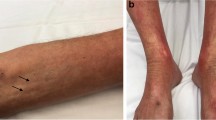Abstract
Background
Generalized morphea and eosinophilic fasciitis are difficult-to-treat inflammatory and sclerosing skin diseases. Few cases have been reported in which intravenous immunoglobulins were of benefit, possibly owing to their immunomodulatory and antifibrotic properties.
Objectives
We present three new patients with generalized morphea treated with intravenous immunoglobulins as well as a review of the literature.
Materials & Methods
Three hospitalized patients (two men, age 66 and 65 years, respectively, and a 67-year-old woman) with generalized morphea who received therapy for the first time are described.
Results
The three patients were treated with intravenous immunoglobulins (1.5–2 g/kg body weight over three to four consecutive days every four weeks). This was combined with corticosteroid pulse therapy in all patients, methotrexate in two patients and mycophenolate mofetil in one patient, respectively. Marked and steady improvement of skin sclerosis was evident in all patients, one to five months after treatment initiation. No adverse events were observed. To date, there are 12 reports of 16 patients with generalized morphea or eosinophilic fasciitis treated with intravenous immunoglobulins. The treatment was highly effective in the majority of patients (9/16) and yielded a favourable risk profile.
Conclusion
Our cases add to the hitherto limited evidence that the administration of intravenous immunoglobulins in combination with glucocorticoids and conventional immunosuppressive agents is a safe and effective therapy against morphea. It seems appropriate to verify these results in future high-quality studies.
Similar content being viewed by others
References
Kreuter A, Krieg T, Worm M, et al. German guidelines for the diagnosis and therapy of localized scleroderma. J Dtsch Dermatol Ges 2016; 14: 199–216.
Mertens JS, Seyger MMB, Thurlings RM, Radstake T, de Jong E. Morphea and eosinophilic fasciitis: an update. Am J Clin Dermatol 2017; 18: 491–512.
Asano Y, Fujimoto M, Ishikawa O, et al. Diagnostic criteria, severity classification and guidelines of localized scleroderma. J Dermatol 2018; 45: 755–80.
Heck J, Olk J, Kneitz H, Hamm H, Goebeler M. Long-standing morphea and the risk of squamous cell carcinoma of the skin. J Dtsch Dermatol Ges 2020; 18: 669–73.
Enk A, Hadaschik E, Eming R, et al. European Guidelines (S1) on the use of high-dose intravenous immunoglobulin in dermatology. J Dtsch Dermatol Ges 2017; 15: 228–41.
World Medical Association. Declaration of Helsinki: ethical principles for medical research involving human subjects. JAMA 2013; 310: 21914.
Bani-Sadr F, Leautez S, el Kouri D, Hamidou M, Barrier JH, Raffi F. Value of immunoglobulins in Schulman fasciitis. Presse Med 2000; 29: 307.
Barrier JH, Ponge T, Andrieu C, et al. Utilisation des immunoglobulines intraveineuses aucours de la fasciite de Shulman corticoresistante?. Rev Med Interne 2001; 22: 109.
El-Jammal T, Gerfaud-Valentin M, Durupt F, et al. Eosinophilic fasciitis and common variable immunodeficiency: an unusual association and literature review. J Allergy Clin Immunol Pract 2019; 7: 2848–90.
Gutierrez D, Peterson EL, Kim RH, Franks AG, Jr., Lo Sicco KI. eosinophilic fasciitis with concomitant morphea profunda treated with intravenous immunoglobulin. J Clin Rheumatol 2019.
Küçükoğlu R, Yilmaz Z, Kutlay A. Treatment of recalcitrant generalized morphea with mycophenolate mofetil and intravenous immunoglobulin. Dermatol Ther 2018; 31: e12674.
Nahhas AF, Alam M, Lim HW. Rituximab as a therapeutic consideration for refractory eosinophilic fasciitis. Int J Dermatol. 2018; 57: 614–5.
Odhav A, Hoeltzel MF, Canty K. Pansclerotic morphea with features of eosinophilic fasciitis: distinct entities or part of a continuum? Pediatr Dermatol 2014; 31: e42–7.
Pimenta S, Bernardes M, Bernardo A, Brito I, Castro L, Simoes-Ventura F. Intravenous immune globulins to treat eosinophilic fasciitis: a case report. Joint Bone Spine 2009; 76: 572–4.
Soh HJ, Samuel C, Heaton V, Renton WD, Cox A, Munro J. Challenges in the diagnosis and treatment of disabling pansclerotic morphea of childhood: case-based review. Rheumatol Int 2019; 39: 933–41.
Tkachenko E, Steuer AB, Lo K, et al. Intravenous immunoglobulin for refractory eosinophilic fasciitis: a retrospective analysis from 3 tertiary care centers. J Am Acad Dermatol 2019; S0190–9622: 33297–9.
Vilchez-Oya F, Sanchez-Schmidt JM, Agusti A, Pros A. The use of tocilizumab in the treatment of refractory eosinophilic fasciitis: a case-based review. Clin Rheumatol 2020; 39: 1693–8.
Wollina U, Looks A, Schneider R, Maak B. Disabling morphoea of childhood-beneficial effect of intravenous immunoglobulin therapy. Clin Exp Dermatol 1998; 23: 292–3.
Cantarini L, Rigante D, Vitale A, et al. Intravenous immunoglobulins (IVIG) in systemic sclerosis: a challenging yet promising future. Immunol Res. 2015; 61: 326–37.
Blank M, Levy Y, Amital H, Shoenfeld Y, Pines M, Genina O. The role of intravenous immunoglobulin therapy in mediating skin fibrosis in tight skin mice. Arthritis Rheum 2002; 46: 1689–90.
Kajii M, Suzuki C, Kashihara J, et al. Prevention of excessive collagen accumulation by human intravenous immunoglobulin treatment in a murine model of bleomycin-induced scleroderma. Clin Exp Immunol 2011; 163(2): 235–41.
Kudo H, Jinnin M, Yamane K, et al. Intravenous immunoglobulin treatment recovers the down-regulated levels of Th1 cytokines in the sera and skin of scleroderma patients. J Dermatol Sci 2013; 69: 77–80.
Gomes JP, Santos L, Shoenfeld Y. Intravenous immunoglobulin (IVIG) in the vanguard therapy of Systemic Sclerosis. Clin Immunol 2019; 199: 25–8.
Jolles S, Sewell WA, Misbah SA. Clinical uses of intravenous immunoglobulin. Clin Exp Immunol 2005; 142: 1–11.
Author information
Authors and Affiliations
Corresponding authors
Additional information
Disclosures
Funding sources: none. Conflicts of interest: none.
About this article
Cite this article
Kromer, C., Mitterlechner, L., Langer, N. et al. Response of recalcitrant generalized morphea to intravenous immunoglobulins (IVIg): three cases and a review of the literature. Eur J Dermatol 31, 822–829 (2021). https://doi.org/10.1684/ejd.2021.4173
Accepted:
Published:
Issue Date:
DOI: https://doi.org/10.1684/ejd.2021.4173



